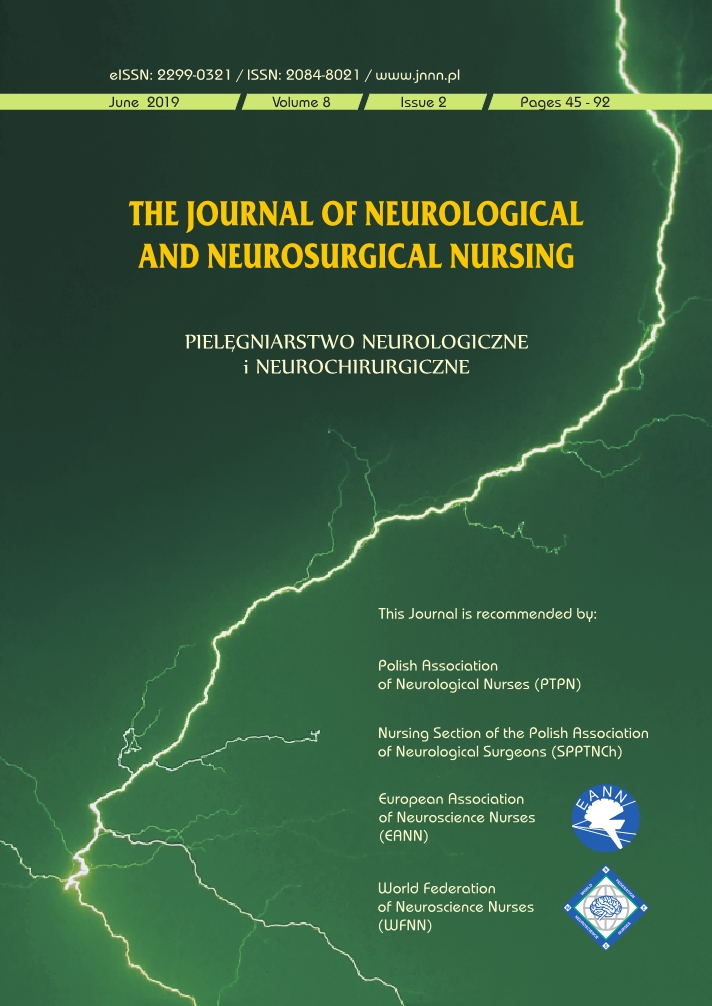Stymulacja neurorozwojowa dziecka z zespołem Noonana z rzadką mutacją w genie RAF1 — opis przypadku
DOI:
https://doi.org/10.15225/PNN.2019.8.2.5Słowa kluczowe
Zespół Noonana, Mutacja genu RAF1, pediatryczna diagnoza kliniczna, interdyscyplinarna rehabilitacja, rozwój psychoruchowy, interwencja logopedycznaAbstrakt
Wstęp. Zespół Noonana (NS) to choroba uwarunkowana genetycznie, dziedziczona w sposób autosomalnie dominujący. Około 50% pacjentów posiada mutację w genie PTPN11. Mutacje w innych genach są znacznie rzadsze, do 10–15% dla SOS1, RAF1 i RIT1, a także do 1–2% dla innych.
Cel. Przedstawienie obrazu klinicznego dziecka z NS z nieczęstą mutacją w genie RAF1 i opisanie propozycji dobrej praktyki opartej na wielospecjalistycznych procedurach opieki nad dzieckiem stosowanych od urodzenia do 3 roku życia.
Opis przypadku. Artykuł przedstawia chłopca z NS, jego rozwój psychomotoryczny i językowy w ciągu 36 miesięcy życia. Niemowlę urodziło się przez cięcie cesarskie w średnim stanie ogólnym z cechami makrosomii. Techniki rehabilitacji Castillo-Moralesa zastosowano w celu poprawy koordynacji ssania, połykania i oddychania. Na oddziale szpitalnym zastosowano również terapię neurorozwojową Bobath. Rozwój dziecka NS oceniono za pomocą Monachijskiej Funkcjonalnej Diagnostyki Rozwojowej (MFDD). W wieku 36 miesięcy chłopiec przedstawia rozwój psychoruchowy odpowiedni do wieku zdrowego dziecka. Pozostaje pod opieką zespołu wielodyscyplinarnego i jest intensywnie rehabilitowany zarówno pod kątem rozwoju ruchowego jak i językowego.
Dyskusja. Zarządzanie NS powinno być kompleksowe i wielodyscyplinarne, a ciągłe monitorowanie pacjentów ma kluczowe znaczenie. Chociaż wielu pacjentów doświadcza trudności w uczeniu się i łagodnej postaci upośledzenia umysłowego, diagnoza NS nie predysponuje do zaburzeń psychicznych.
Wnioski. NS jest chorobą wieloobjawową, manifestującą się objawami klinicznymi wymagającymi interdyscyplinarnej współpracy wielu specjalistów. Faktem jest, że zidentyfikowanie mutacji genu RAF1 u pacjentów z NS nie oznacza, że są oni predysponowani do rozwoju zaburzeń psychoruchowych. (PNN 2019;8(2):78–85)
Bibliografia
Lepri F.R., Scavelli R., Digilio M.C. et al. Diagnosis of Noonan syndrome and related disorders using target next generation sequencing. BMC Med Genet. 2014;15:14.
Bhambhani V., Muenke M. Noonan syndrome. Am Fam Physician. 2014;89(1):37–43.
Bezniakow N., Gos M., Obersztyn E. The RASopathies as an example of RAS/MAPK pathway disturbances — clinical presentation and molecular pathogenesis of selected syndromes. Dev Period Med. 2014;18(3):285–296.
Cizmarova M., Kostalova L., Pribilincova Z. et al. Rasopathies — dysmorphic syndromes with short stature and risk of malignancy. Endocr Regul. 2013;47(4):217–222.
Tidyman W.E., Rauen K.A. Noonan, Costello and cardio-facio-cutaneous syndromes: dysregulation of the Ras-MAPK pathway. Expert Rev Mol Med. 2008;10:e37.
Tartaglia M., Pennacchio L.A., Zhao C. et al. Gain-of-function SOS1 mutations cause a distinctive form of Noonan syndrome. Nat Genet. 2007;39(1):75–79.
Gos M., Leszkiewicz M., Abramowicz A. RAS/MAPK signal transduction pathway and its role in the pathogenesis of Noonan syndrome. Postepy Biochem. 2012;58(3):255–264.
Malaquias A.C., Brasil A.S., Pereira A.C. et al. Growth standards of patients with Noonan and Noonan-like syndromes with mutations in the RAS/MAPK pathway. Am J Med Genet A. 2012;158A(11):2700–2706.
Yaoita M., Niihori T., Mizuno S. et al. Spectrum of mutations and genotype-phenotype analysis in Noonan syndrome patients with RIT1 mutations. Hum Genet. 2016;135(2):209–222.
Nemcikova M., Vejvalkova S., Fencl F., Sukova M., Krepelova A. A novel heterozygous RIT1 mutation in a patient with Noonan syndrome, leukopenia, and transient myeloproliferation-a review of the literature. Eur J Pediatr. 2016;175(4):587–592.
Thompson D., Patrick-Esteve J., Surcouf J.W. et al. RAF1 variants causing biventricular hypertrophic cardiomyopathy in two preterm infants: further phenotypic delineation and review of literature. Clin Dysmorphol. 2017;26(4):195–199.
Markiewicz K., Pachalska M. Diagnosis of severe developmental disorders in children under three years of age. Med Sci Monit. 2007;13(2):CR89–99.
Tafazoli A., Eshraghi P., Koleti Z.K., Abbaszadegan M. Noonan syndrome — a new survey. Arch Med Sci. 2017;13(1):215–222.
Roberts A.E., Allanson J.E., Tartaglia M., Gelb B.D. Noonan syndrome. Lancet. 2013;381(9863):333–342.
Sullivan P.B. Gastrointestinal disorders in children with neurodevelopmental disabilities. Dev Disabil Res Rev. 2008;14(2):128–136.
Romano A.A., Allanson J.E., Dahlgren J. et al. Noonan syndrome: clinical features, diagnosis, and management guidelines. Pediatrics. 2010;126(4):746–759.
van der Burgt I. Noonan syndrome. Orphanet J Rare Dis. 2007;2:4.
Şıklar Z., Genens M., Poyrazoğlu Ş. et al. The Growth Characteristics of Patients with Noonan Syndrome: Results of Three Years of Growth Hormone Treatment: A Nationwide Multicenter Study. J Clin Res Pediatr Endocrinol. 2016;8(3):305–312.
Roelofs R.L., Janssen N., Wingbermühle E., Kessels R.P., Egger J.I. Intellectual development in Noonan syndrome: a longitudinal study. Brain Behav. 2016;6(7):e00479.
Pierpont E.I., Ellis Weismer S., Roberts A.E. et al. The language phenotype of children and adolescents with Noonan syndrome. J Speech Lang Hear Res. 2010;53(4):917–932.
Selås M., Helland W.A. Pragmatic language impairment in children with Noonan syndrome. Clin Linguist Phon. 2016:30(11):899–910.
Roelofs R.L., Wingbermühle E., Freriks K., Verhaak C.M., Kessels R.P., Egger J.I. Alexithymia, emotion perception, and social assertiveness in adult women with Noonan and Turner syndromes. Am J Med Genet A. 2015;167A(4):768–776.
Wingbermühle E., Roelofs R.L., van der Burgt I. et al. Cognitive functioning of adults with Noonan syndrome: a case-control study. Genes Brain Behav. 2012;11(7):785–793.
Pobrania
Opublikowane
Jak cytować
Numer
Dział
Licencja

Utwór dostępny jest na licencji Creative Commons Uznanie autorstwa – Bez utworów zależnych 4.0 Międzynarodowe.
Statystyki
Liczba wyświetleń i pobrań: 295
Liczba cytowań: 0
